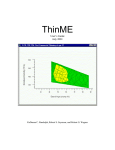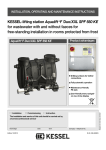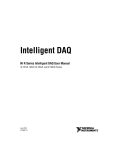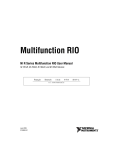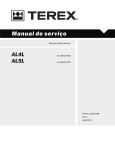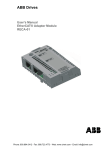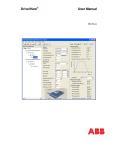Download ABB ACS800 RSYC-01 Synchronizing Unit User`s Manual
Transcript
ACS800 User’s Manual RSYC-01 Synchronizing Unit Phone: 800.894.0412 - Fax: 888.723.4773 - Web: www.clrwtr.com - Email: [email protected] Phone: 800.894.0412 - Fax: 888.723.4773 - Web: www.clrwtr.com - Email: [email protected] RSYC-01 Synchronizing Unit User’s Manual Code: 3AFE68827370 REV A EN EFFECTIVE: 29.06.2007 FIDRI\EIF200 © 2007 ABB Oy. All Rights Reserved. Phone: 800.894.0412 - Fax: 888.723.4773 - Web: www.clrwtr.com - Email: [email protected] Phone: 800.894.0412 - Fax: 888.723.4773 - Web: www.clrwtr.com - Email: [email protected] 5 Table of contents Table of contents............................................................................................................................ 5 Introduction to the manual ............................................................................................................ 7 What this chapter contains ............................................................................................................... 7 Compatibility..................................................................................................................................... 7 Safety instructions ............................................................................................................................ 7 Intended audience............................................................................................................................ 7 Other manuals.................................................................................................................................. 7 Description of operation and hardware ........................................................................................ 9 What this chapter contains ............................................................................................................... 9 Intended use of the RSYC unit ......................................................................................................... 9 Operation ......................................................................................................................................... 9 Overall view of the unit ................................................................................................................... 10 RSYC-01 unit with cover............................................................................................................ 10 RSYC-01 unit without cover ....................................................................................................... 10 Connection diagram ....................................................................................................................... 11 Terminals/connections of the RSYC unit ........................................................................................ 12 Connections of RSYC unit to the drive ........................................................................................... 12 Mechanical installation ................................................................................................................ 13 What this chapter contains ............................................................................................................. 13 Delivery check / contents of the RSYC kit....................................................................................... 13 Mechanical installation ................................................................................................................... 14 Mounting the RSYC unit ............................................................................................................ 14 Electrical installation.................................................................................................................... 15 What this chapter contains ............................................................................................................. 15 Connection diagram ....................................................................................................................... 15 Considerations ............................................................................................................................... 15 Cable clamping and grounding example......................................................................................... 16 Start-up ......................................................................................................................................... 17 What this chapter contains ............................................................................................................. 17 Parameter settings ......................................................................................................................... 17 Checking the operation of the RSYC unit ....................................................................................... 18 Checking of the trim function and synchronization.......................................................................... 19 Final check ..................................................................................................................................... 20 Disabling the synchronization ......................................................................................................... 20 Table of contents Phone: 800.894.0412 - Fax: 888.723.4773 - Web: www.clrwtr.com - Email: [email protected] 6 Resetting the system.......................................................................................................................20 Fault tracing...................................................................................................................................21 What this chapter contains ..............................................................................................................21 Troubleshooting hints ......................................................................................................................21 Measuring with an oscilloscope .......................................................................................................22 Miscellaneous measurement graphs ...............................................................................................24 Technical data ...............................................................................................................................25 Dimension drawing .......................................................................................................................27 Cover of the RSYC enclosure .........................................................................................................27 RSYC enclosure body .....................................................................................................................28 Table of contents Phone: 800.894.0412 - Fax: 888.723.4773 - Web: www.clrwtr.com - Email: [email protected] 7 Introduction to the manual What this chapter contains This chapter includes a description of the contents of the manual. In addition it contains information about the compatibility, safety and intended audience. Compatibility The manual is compatible with RSYC-01 Synchronizing Unit. The drive parameter data refers to ACS800 Standard Control Program. Safety instructions Follow all safety instructions delivered with the drive. • Read the complete safety instructions before you install, commission, or use the drive. The complete safety instructions are given at the beginning of the drive Hardware Manual. • Read the software function specific warnings and notes before changing the default settings of the function. For each function, the warnings and notes given in this manual in the section describing the related user-adjustable parameters. Intended audience This manual is intended for the people who are responsible for installing, commissioning, using and trouble shooting the synchronization system with the RSYC unit. The reader is expected to have knowledge of electrical fundamentals, electrical wiring practices, electronic components, and electrical schematic symbols. The person in charge of testing and commissioning a system this complicated must be an experienced professional in the field of electrotechnics. Other manuals Hardware Manual of the drive. ACS800 Standard Control Program 7.x Firmware Manual (3AFE64527592 [English]). Introduction to the manual Phone: 800.894.0412 - Fax: 888.723.4773 - Web: www.clrwtr.com - Email: [email protected] 8 Introduction to the manual Phone: 800.894.0412 - Fax: 888.723.4773 - Web: www.clrwtr.com - Email: [email protected] 9 Description of operation and hardware What this chapter contains This chapter describes the operation of a synchronization application, shows a connection diagram and presents the RSYC unit. Intended use of the RSYC unit A drive equipped with the RSYC unit is designed for applications in which a large fixed-speed motor must be started to a weak supply line. Drive starts the motor smoothly (no high starting current as with the direct on line start) simultaneously generating a high torque. When the nominal speed (frequency) is reached, RSYC unit verifies the status of the supply line and the drive output and controls the switch-over contactors that shift the connection of motor from the drive to supply line. Operation The RSYC unit monitors two voltage signals, one measured from the supply line and other from the drive output. The signals indicate the phase shift and frequency. The unit output signal (BUFOUT, 0 …10 V) indicates the synchronization status for the drive. When the BUFOUT signal reaches 5 volts, the supply line and the drive output voltages are synchronic, i.e. the phasing and frequency are the same. The drive control program constantly corrects the drive frequency reference (set to 50 Hz) on basis of the BUFOUT signal by using the Trim function. When the synchronizing conditions are reached, i.e. the drive output and the supply line phasing’s match and the frequencies are equal: • BUFOUT signal reaches 5 volts indicating “synchronic” status for the drive application program. • RSYC unit gives a control pulse for the contactor control circuitry. • Drive control logic switches the inverter modulation (IGBT control pulses) off. • Contactor control circuit opens contactor K1, disconnecting the motor from drive. • Contactor control circuit closes contactor K2, connecting the motor to the supply line. Description of operation and hardware Phone: 800.894.0412 - Fax: 888.723.4773 - Web: www.clrwtr.com - Email: [email protected] 10 Overall view of the unit RSYC-01 unit with cover 2) 3) 1) RSYC-01 unit without cover 4) 4) 1) +24 V DC supply for the RSYC-01 unit 2) SYNC signal (K4) and BUF OUT signal 3) Inverter output (T2) and network supply (T1) measurement transformer signals 4) Cable screen clamps. Description of operation and hardware Phone: 800.894.0412 - Fax: 888.723.4773 - Web: www.clrwtr.com - Email: [email protected] 11 Connection diagram Description of operation and hardware Phone: 800.894.0412 - Fax: 888.723.4773 - Web: www.clrwtr.com - Email: [email protected] 12 T1 – Supply line voltage measurement as 10 … 120 V AC signal (3-phase potential measuring transformer with static shield) T2 – Motor voltage measurement as 10 … 120 V AC signal (3-phase potential measuring transformer with static shield) Terminals/connections of the RSYC unit Terminal Name Description 1 +24 V 2 COM Synchronizing unit power supply from the Motor Control and I/O board (RMIO) via terminal X23. J1 J2 1 2 3 SYNC COM COM Output 0/24 V control pulse for external contactor control circuitry BUFOUT Output 0 … 10 V signals indicating the synchronization status for the drive. INVRTR Motor voltage measurement MAINS Supply line voltage measurement J3 1 2 3 4 Connections of RSYC unit to the drive Name Description 3 AI1+ Synchronization status indication 4 AI1- Synchronization status indication 5 D15 Run enable 6 D16 Not in use 7 +24 V 24 V for run enable 1 +24 V Power supply for RSYC 2 GND Power supply for RSYC RMIO board terminal X21 X22 X23 Description of operation and hardware Phone: 800.894.0412 - Fax: 888.723.4773 - Web: www.clrwtr.com - Email: [email protected] 13 Mechanical installation What this chapter contains This chapter contains mounting rail instructions and contents of the RSYC kit. Delivery check / contents of the RSYC kit RSYC kit contains: • RSYC unit • two synchronizing transformers • 8 meters of cable for RSYC connections • this manual. Note: Following items are not included but must be acquired separately: switchover contactors, the relays of the contactor control circuit, cable between transformer T1 and main circuit (and fuses for the cable), and cable between transformer T2 and main circuit (and fuses for the cable). Mechanical installation Phone: 800.894.0412 - Fax: 888.723.4773 - Web: www.clrwtr.com - Email: [email protected] 14 Mechanical installation Mounting the RSYC unit Mount the unit by snapping the feet onto a 7.5 × 35 mm mounting rail (1) (2). Mounting Mechanical instalation Phone: 800.894.0412 - Fax: 888.723.4773 - Web: www.clrwtr.com - Email: [email protected] 15 Electrical installation What this chapter contains This chapter contains a reference to the connection diagram and a list of items to consider in the electrical installation. Connection diagram See Connection diagram on page 11. Considerations Follow the cabling recommendations of the drive Hardware Manual. Leave at least 0.5 m space between the unit and the power cables and drive module. If 0.5 m is impossible, install as far as possible. Use shielded twisted-pair cables between the transformers and the RSYC unit. Ground the shields with as short pigtails as possible. Cut and insulate any unused conductors at both ends of the cables. See Connection diagram. Use shielded twisted-pair cables between the RSYC unit and the drive. Ground the shields at the drive module end according to the instructions given in the drive Hardware Manual. Use shielded twisted-pair cables between the unit and the contactor control circuitry. Ground the shields with as short pigtails as possible. Dimension selects the cable in between the main circuit and the synchronizing transformers according to the main circuit voltage. Protect the cable with fuses if necessary. Electrical installation Phone: 800.894.0412 - Fax: 888.723.4773 - Web: www.clrwtr.com - Email: [email protected] 16 Cable clamping and grounding example To network supply measurement transformer To inverter output supply measurement transformer J3 J2 J1 +24 V DC supply BUF OUT signal SYNC signal Electrical installation Phone: 800.894.0412 - Fax: 888.723.4773 - Web: www.clrwtr.com - Email: [email protected] 17 Start-up What this chapter contains This chapter instructs in setting the drive parameters and in checking the system. Parameter settings The table below instructs in parameter settings for a drive with ACS800 Standard Control Program starting a four-pole motor (50 Hz). With these settings, the trim control can affect ±20 rpm to final speed reference (1% of the defined maximum speed limit). Here, the panel will be used as the external control signal interface. That is the recommended practise at the start-up. Change later to I/O or fieldbus control if needed. However note that analogue input AI1 and digital input DI5 are reserved for the synchronization application. Before starting, ensure that the contactor control circuit connection at terminal J2 of the RSYC unit is disconnected. For the use of control panel, see ACS800 Standard Control Program 7.x Firmware Manual (3AFE64527592 [English]). Setting Parameter value Additional information Selecting control location and signal sources Select external control location EXT2 into use. 11.02 = EXT2 Define control panel for source of control commands for external control location EXT2. 10.02 = KEYPAD Define control panel for source of speed reference for external control location EXT2. 11.06 = KEYPAD Fix rotation direction of motor to forward. 10.03 = FORWARD Deactivate constant speed selections. 12.01 = Inactive Set digital input DI5 to source for run enable signal. 16.01 = DI5 See section Connection diagram on page 11. Define maximum and minimum limits for the motor speed. 20.01 = 0.00 rpm Maximum speed must be higher than motor nominal speed. 2000 is suitable value for a 4pole, 50 Hz motor. Define the stop mode for the run enable function. 20.02 = 2000.00 rpm 20.07 = COAST Trim function can be used only with % reference (REF2). REF2 can be given from various interfaces. Here, control panel (KEYPAD) will be used. Change of direction is disabled. The drive will cut off output voltage immediately after run enable is switched off. Settings of PID controller used by Trim function, Parameter group 40 Activate error value inversion. 40.05 = YES RSYC unit feature. Activate ACT1 for PID controller. 40.06 = ACT1 - Start-up Phone: 800.894.0412 - Fax: 888.723.4773 - Web: www.clrwtr.com - Email: [email protected] 18 Setting Parameter value Additional information Select analogue input AI1 for actual signal for PID controller. 40.07 = AI1 BUF OUT signal from RSYC unit, 0 … 10 V. Below 5 V = supply line frequency exceeds drive output frequency. 5 V = Supply line frequency and drive output frequency are equal and phases match. Above 5 V = supply line frequency is lower than drive output frequency Set minimum value for ACT1. 40.09 = 0.00% - Set maximum value for ACT1. 40.10 = 100.00% - Deactivate integration term of PID controller. 40.13 = OFF - Activate Trim function and define trimming relative to maximum speed. 40.14 = DIRECT PID controller output is relative to maximum speed limit (Par. 20.02). Select parameter 40.16 for the source of the trim reference. 40.15 = PAR 40.16 Set trim reference to 50%. 40.16 = 50.00% Trim reference is equal to actual signal when the synchronization conditions are valid i.e. when AI1= 5 V. See parameter 40.07 above. Define the maximum effect of trim (that is added to the drive reference) 40.17 = 1.00% - Macro selection and motor control mode Select factory macro. 99.02 = FACTORY Other macros except PID CNTRL are also possible (PID cannot be used as the PID controller is reserved for Trim function). Select motor control mode. 99.04 = DTC - Define the motor parameters. 99.05 …99.10 See ACS800 Standard Control Program 7.x Firmware Manual (3AFE64527592 [English]). Checking the operation of the RSYC unit WARNING! Read and follow the instructions in the drive Hardware Manual. Ignoring the instructions can cause physical injury or death, or damage to the equipment. Ensure that the drive is disconnected from the supply line and all other precautions described in the safety instructions have been taken into consideration. Before starting, ensure that the contactor control circuit connection at terminal J2 of the RSYC unit is disconnected. For the use of control panel, see ACS800 Standard Control Program 7.x Firmware Manual (3AFE64527592 [English]). Start-up Phone: 800.894.0412 - Fax: 888.723.4773 - Web: www.clrwtr.com - Email: [email protected] 19 Action Additional information Check unit visually. - Set drive parameters according to instructions. However, switch Trim function off (parameter 40.14 = OFF) for the time being. See Parameter settings on page 17. Shift control panel to local control mode. Use LOC/REM key. Letter L on first row of display indicates local control. Select following actual values to panel display: 01.02 SPEED, 01.03 FREQUENCY, 01.18 AI1 [V]. AI1 is the 0 … 10 V DC status signal from the unit. Start drive and increase speed reference until output frequency is as close to 50 Hz as possible. Write down actual speed and speed reference at 50 Hz output frequency. The difference between the speed reference and the actual speed depends on the slip which, in turn, depends on the motor load. Drop speed so that output frequency is 45 … 47 Hz. Ensure that AI1 is 8 … 10 V DC. - Increase speed reference so that output frequency is 52 … 55 Hz. Ensure that AI1 is 0 … 1 V DC. - Stop the drive. - Checking of the trim function and synchronization This check makes sure that the trim function affects the speed control of the drive in the correct manner. Finding a right value for trim range adjustment (parameter 40.17) is essential for stable control and fast synchronization. Then the system reaches the synchronization with decreasing oscillations around 50 Hz and actual signal for Trim function (AI1) settles to approximately 5 V DC. For the use of control panel, see ACS800 Standard Control Program 7.x Firmware Manual (3AFE64527592 [English]). Reserve at hand the value of the speed reference and actual speed that were equivalent to 50 Hz output frequency (defined in the previous section). Checking the operation of the RSYC unit on page 18. Actions Information Set drive parameters according to instructions. However, switch Trim function off (parameter 40.14 = OFF) for the time being. See Parameter settings on page 17. Use LOC/REM key to select remote control. The drive is now ready to be controlled externally with the control panel. Letter R on first row of display indicates remote control mode of panel. Start drive. - Set speed reference to value that was equivalent to 50 Hz output frequency. - Check output frequency from display. If it is not 50 Hz adjust the reference in small steps so that output frequency from display shows 50 Hz. Write down this value again. - Stop drive. - Set trim function on (parameter 40.14 TRIM MODE = DIRECT). The speed reference and output frequency will now be affected by Trim function slightly. Start-up Phone: 800.894.0412 - Fax: 888.723.4773 - Web: www.clrwtr.com - Email: [email protected] 20 Actions Information Start drive and monitor panel and RSYC status LED. The following indicates successful Trim control loop: - Drive accelerates to speed reference which was defined above. - Output frequency starts oscillating around 50 Hz. - AI1 is 2.5 V … 7 V. - RSYC LED blinks the first time after 5 … 20 seconds. - LED starts blinking in shorter time intervals and finally LED illuminates steady for several seconds. - Increase 40.17 TRIM RANGE ADJUST slightly (e.g. 1 … 5%) if faster synchronization is required. Excessive value may lead to unstable control. Stop drive. Final check Action Additional information Connect the contactor control circuit cable (J2/SYNC) to RSYC unit. - Test the system and verify the operation. - The system will synchronize in less than 15 seconds and will remain in the synchronization status for tens of seconds when it is properly installed and commissioned. Disabling the synchronization To disable synchronization function: • Change the external control location in the drive application program from EXT2 to EXT1 (parameter 11.02) or switch the drive to local control mode by the LOC/REM key of the control panel. • Turn operating switch S1 in the contactor control circuit to the OFF position. Resetting the system The relay logic can be reset to initiate another synchronizing cycle by turning the operating switch S1 of the contactor control circuit to the OFF position and then to ON again (1-0-1). Start-up Phone: 800.894.0412 - Fax: 888.723.4773 - Web: www.clrwtr.com - Email: [email protected] 21 Fault tracing What this chapter contains This chapter gives the troubleshooting information. Troubleshooting hints Trouble Cause Remedy Unit operates illogically despite all connections and parameters are correct. The board is affected by radiated interference. BUF OUT signal is not stable and as a consequence synchronization is not possible. Ensure all cables that connect to the RSYC unit are shielded and shields are properly grounded. Install an additional metal shield between the emission source and the unit. Change location of the unit, i.e. arrange more space between the emission source (drive module or motor cables) unit. BUF OUT signal from RSYC board is constantly low i.e.0 … 1 V DC. Signals from synchronizing transformers are cross-connected at the RSYC unit. Check and correct connections. Drive output frequency remains too close to 50 Hz and occasional short synchronization pulses take place. Too small value for parameter 40.17 TRIM RANGE ADJUST. Drive cannot control the speed (and output frequency) loosely enough. Increase the value of parameter 40.17. The speed control is unstable. Too large value for parameter 40.17 TRIM RANGE ADJUST causes the control to overcompensate. Decrease the value of parameter 40.17. Excessive motor current peak at synchronization. Rotor decelerates too fast and phase difference between stator and motor fluxes increase too much. Make contactors operate faster if possible. Contactors can operate simultaneously. Connect a serial inductor (3 phase choke) to the motor AC input during switching of change-over contactors. Equip the choke with a by-pass contactor (the choke does not need to be dimensioned according to continuous current, only the contactor). The choke must not saturate through. See Connection diagram on page 11. Motor flux decreases too much during the operation of change-over contactors. High current is needed to remagnetize the motor. Check and correct the transformer connection. Supply line (motor) and drive output are 180º out of phase due to wrong connection of the synchronization transformer. Check and correct the transformer connection. Supply line and drive output are 180º out of phase since the phasing between motor and supply line differs from the phasing between motor and drive output. Check and change the connections. Fault tracing Phone: 800.894.0412 - Fax: 888.723.4773 - Web: www.clrwtr.com - Email: [email protected] 22 Measuring with an oscilloscope Checking the supply line (MAINS) and inverter output (INVRTR) signals from the board may be the only way to see what is actually happening if there is no SYNC signal. There is a potential interference risk as it is possible that the probes pick-up the interference and conduct it to the board circuits. All loops should be kept as small as possible and measuring circuits should be routed as far away from the drive and other cables as possible. The following figure shows the measuring points TP3 – TPVREF and TP4 - TPVREF. Fault tracing Phone: 800.894.0412 - Fax: 888.723.4773 - Web: www.clrwtr.com - Email: [email protected] 23 When the signals are in synchronization, the oscilloscope shows the following waveforms. When there is a phase difference, the waveforms are as shown in the graphic below. When the frequencies are different, the signals move respective to each other. If the “speed” is low enough, the board may generate a SYNC pulse. Fault tracing Phone: 800.894.0412 - Fax: 888.723.4773 - Web: www.clrwtr.com - Email: [email protected] 24 Miscellaneous measurement graphs The graph below shows the measurements of the voltages (Uu-v and Uv-w) and phase currents (Iu and Iw) when synchronizing to the network. 1200 1000 800 600 400 Iu Uu-v 200 Iw 0 -200 1 96 191 286 381 476 571 666 761 856 951 1046 1141 1236 1331 1426 Uv-w -400 -600 -800 -1000 The graph below shows the drive output voltage, network voltage and one phase current. Fault tracing Phone: 800.894.0412 - Fax: 888.723.4773 - Web: www.clrwtr.com - Email: [email protected] 25 Technical data RSYC power supply voltage 24 V DC (-5 … +5%) RSYC power consumption 25 … 35 mA Signal cable type Signal cable size Signal cable use JAMAK by NK Cables 2 2 × (2+1) × 0.5 mm Connection of the RSYC unit to the drive, transformers and control relays Synchronization accuracy -21 … +21º Transformer cable size Transformer cable use Max. cross-section = 4 mm Connection between the measuring transformers and main circuit (at drive output and input). Mounting rail 7.5 × 35 mm (EN50022) Measuring transformer e.g. 3AFE58125130, 690/43.3 V, 3 VA, 45 … 65 Hz Primary voltage 690 V AC 45 …65 Hz Secondary voltage 43,3 V AC 45 … 65 Hz Power 3 VA Winding connection Dyn 11 Winding separation Static screen 2 Technical data Phone: 800.894.0412 - Fax: 888.723.4773 - Web: www.clrwtr.com - Email: [email protected] 26 Technical data Phone: 800.894.0412 - Fax: 888.723.4773 - Web: www.clrwtr.com - Email: [email protected] 27 Dimension drawing Cover of the RSYC enclosure The dimensions are given in millimetres. Dimension in mm. 1 mm = 0.039” 1” = 25.4 mm Dimension drawing Phone: 800.894.0412 - Fax: 888.723.4773 - Web: www.clrwtr.com - Email: [email protected] 28 RSYC enclosure body Dimension drawing Phone: 800.894.0412 - Fax: 888.723.4773 - Web: www.clrwtr.com - Email: [email protected]




























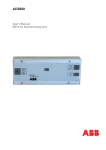

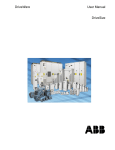


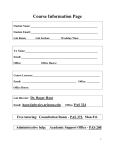

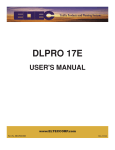
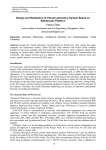
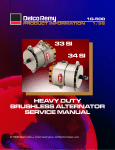
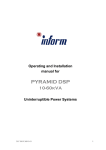
![[ENG] EVO DSP TM 10-30 kVA User Manual v. 2.0](http://vs1.manualzilla.com/store/data/005715238_1-26b73917878f712f842422018d03a475-150x150.png)
